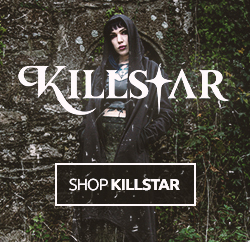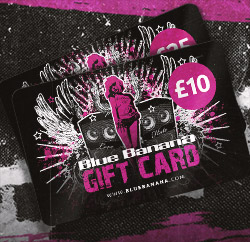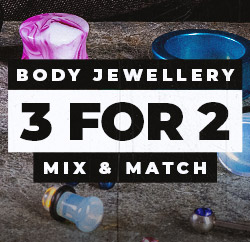
GBP
Sprache Auswählen
Deutsch (Deutschland)
Englisch (Vereinigtes Königreich)
Englisch (Vereinigte Staaten)
Französisch (Frankreich)
Italienisch (Italien)
Spanisch (Spanien)
Menü anzeigen
Menü ausblenden
Kleidung
Kleider
Kapuzen- & Sweatshirts
Jacken & Mäntel
Pullover & Cardigans
Latzkleider & Latzhosen
Shirts & Tops
Jeans & Hosen
Röcke
T-Shirts & Tops
Alle Ansehen
Herbst & Winter
Gothic
Kawaii
Frühling und Sommer
Steampunk
Tartan
TV & Film Merch
Vintage
Hexenhaft
Alle Ansehen
Geschenke & Accessoires
Band Accessoires
Badebomben
Fantasy Geschenke
Gothic Geschenke
Piercing- und Store-Gutschein
Gotische Haaraccessoires
Popkultur Geschenke
Kleine Geschenke
Weihnachtsdeko
Alle Ansehen
Band Merch
Haarfärbemittel
Piercing
Acryl
Schwarzes Titan
Buntes Titan
Opal
Poliertes Titan
Plasma Gold
Gold
Rotgold
Silikon
Chirurgenstahl
Ultraviolett
Weißes Gold
Holz
Alle Ansehen
Ohrmuschel
Anti-Tragus
Conch
Daith
Forward Helix
Helix
Industrial / Scaffold
Ohrläppchen
Orbital
Pinna
Rook
Scapha / Flat
Snug / Anti-Helix
Spiral / Triple Helix
Stretching
Tragus
Alle Ansehen
Angel Bites
Ashley
Canine Bites
Cyber Bites
Dahlia Bites
Dolphin Bites
Jestrum
Labret
Madonna
Medusa
Monroe
Shark Bites
Snake Bites
Spider Bites
Vertical Labret
Viper Bites
Alle Ansehen
Schlüsselbein
Extreme Mods
Weibliche Genitalien
Genitalien
Hand
Hüfte
Männliche Genitalien
Bauchnabel
Hals (Nacken)
Brustwarze
Brustbein / Dekolleté
Surface
Handgelenk
Alle Ansehen
Arten von Schmuck
Alle Ansehen Piercing
Kontaktlinsen
Lass dich piercen
Nachsorge für Ohrpiercing
Nachsorge für Nasenpiercing
Nachsorge für Oralpiercing
Oberflächenpiercing-Nachsorge
Mikrodermale Piercing-Nachsorge
Nachsorge für Genitalpiercing
Nachbehandlung
HOT TOPICS

03.11.2023

22.09.2023

12.09.2023

23.04.2022

LATEST
02.01.2026

18.12.2025

04.12.2025

20.11.2025


Cartilage Piercing Myth Busting: Healing Time, Care and Types
December 20, 2017 15:34
Before you get a piercing it is important to know everything you need to and want to. It isn’t going to help your nerves beforehand if you still have questions to ask, right? Blue Banana is here to put some of those piercing worries to rest and help you enjoy your *cartilage piercing* experience. After all, what could be more exciting than choosing some new jewellery for your piercing?
So here's the lowdown on cartilage piercings –
* **Cartilage piercings** refer to certain nose and ear piercings.
* The **cartilage piercing healing** time is approximately 3 – 1\. months but remember everyone’s bodies will react differently!
* Typically the piercing jewellery used will measure 1.2mm.
The types of jewellery you can wear are BCR, Labret, Segment Ring and Curved/Straight/Circular Barbell. Remember not all of these can be worn straight away.
* You may need to wait until your piercing has healed.
* The types of **ear cartilage piercings** include Helix, Antihelix, Conch, Daith, Rook.
Cartilage piercings tend to be done with a needle as a piercing gun is designed for softer tissue.
# 
# Cartilage Piercing Care
It is time to bust some myths when it comes to caring for cartilage piercings! The common advice for ear cartilage piercings is not to sleep on the piercing itself. Many people think this is because of the pain. However, there’s actually more to it than that! Cartilage piercings can migrate which means the jewellery could move under the skin. Sleeping on your new piercing could push on your jewellery and cause the angle of the piercing to change. Ensuring you don’t knock or apply pressure on your new piercing will help the healing process and minimise the chances of migration.
It isn’t always easy to tell if you have a** cartilage piercing infection** as it is possible you will initially experience some redness and swelling. There are some signs to look out with your cartilage piercing that could be signalling a potential infection. These include: heat around the piercing site, abnormal discharge such as thick pus, extreme pain and/or tenderness. If you experience any of these symptoms seek medical help and if you are unsure about your piercing you can always talk to your piercer. These side effects can sound a bit scary but they are completely avoidable! Remember, with the correct piercing aftercare, it is unlikely you will experience these issues.
So, the question now is; what can you do to avoid getting an infection? There are a few do’s and don’ts when it comes to piercing aftercare. Consider them your Golden Rules as you wait for your piercing to properly heal. The main age old rule is to not fiddle with your jewellery. Twisting you jewellery or picking at your piercing is definitely a no no! Another important step to piercing after care is cleaning. A pinch of salt in an eggcup of water it all it takes to clean your new piercing.
If you would like to find out more about how we rate **cartilage piercing pain** check out our blog post, ‘[Which Piercings Hurt The Most (or Least)!](http://www.bluebanana.com/en/news/which-piercings-hurt-the-most-or-least)’
## Types of Cartilage Piercing Jewellery
All** types of cartilage piercing** will have different suggestions for piercing jewellery so here are some of our favourites!
For [helix](http://www.bluebanana.com/en/section/4645/1/helix-piercing-jewellery) and antihelix piercings,** cartilage piercing earrings** such as barbells and BCRs are a popular choice. In a huge rainbow of colours you are sure to be able to choose your favourites.
[Conch](http://www.bluebanana.com/en/section/4603/1/conch-piercing-jewellery) piercings are in the inner part of the ear so are designed for barbells, labret and BCR jewellery. Remember you can have plenty of fun modifying your piercing jewellery by adding a jewelled ball for extra sparkle.
[Daith](http://www.bluebanana.com/en/section/4635/1/daith-piercing-jewellery) piercings are becoming increasingly popular due to their rumoured abilities to reduce migraines. These are mostly worn with **cartilage piercing hoop** jewellery. A particularly popular style is the heart shaped ring which is sure to look super cute. Rook piercings are similar to daith piercings but are placed on the upper part of the inner ear.
[Nose](http://www.bluebanana.com/en/section/743/1/nose-studs) piercings can also vary in their positioning, just like ear piercings. A nostril piercing is most commonly worn with a small stud so make sure you choose a colour that matches your favourite makeup colour palette.
For more information about our cartilage piercings and piercing studios, make sure to check them out if you’re considering getting a piercing of your own!
For** Cartilage Piercing Prices**, make sure to check out our [pricing pages](http://www.bluebanana.com/en/article/21535/body-piercing-information).
For **Cartilage Piercing Near Me**, go ahead and take a look at our [Studio Locator](http://www.bluebanana.com/en/stores)!







